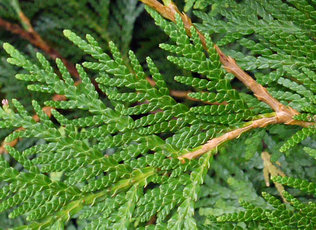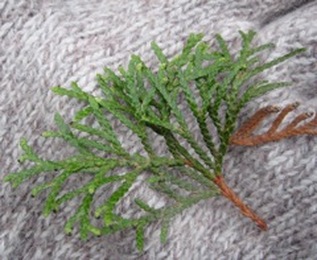| References: ITIS Standard Report Page: Thuja occidentalis. (2013, October 22). Integrated Taxonomic Information System. Retrieved October 22, 2013, from http://www.itis.gov/servlet/SingleRpt/SingleRpt?search_topic=TSN&search_value=505490 Northern White Cedar (Thuja occidentalis). (2013, July 15). Illinois Wildflowers. Retrieved October 22, 2013, from http://www.illinoiswildflowers.info/trees/plants/white_cedar.html Plants Profile for Thuja occidentalis (arborvitae). (n.d.). Welcome to the PLANTS Database | USDA PLANTS. Retrieved October 22, 2013, from http://plants.usda.gov/core/profile?symbol=THOC2 Thuja occidentalis (northern white-cedar) description. (2012, November 28). The Gymnosperm Database: Home Page. Retrieved October 22, 2013, from http://www.conifers.org/cu/Thuja_occidentalis.php Thuja occidentalis Fact Sheet. (n.d.). VT Forest Biology and Dendrology. Retrieved October 22, 2013, from http://dendro.cnre.vt.edu/dendrology/syllabus/factsheet.cfm?ID=118 Yin, X., Lacroix, C., & Barabé, D. (2011). Phyllotactic transitions in seedlings: the case of Thuja occidentalis. Botany, 89(6), 387-396. doi:10.1139/b11-027 Hofmeyer, P. V., Seymour, R. S., & Kenefic, L. S. (2010). Production ecology of Thuja occidentalis. Canadian Journal Of Forest Research, 40(6), 1155-1164. doi:10.1139/X10-070 FORESTER, J. D., ANDERSON, D. P., & TURNER, M. G. (2008). Landscape and Local Factors Affecting Northern White Cedar (Thuja occidentalis) Recruitment in the Chequamegon-Nicolet National Forest, Wisconsin (U.S.A.). American Midland Naturalist, 160(2), 438-453. | American Arborvitae #197: Tree Guide: https://mapsengine.google.com/map/edit?mid=zFDBt15oTJO4.kQSKLJkNTJMo Scientific Name: Thuja Occidentalis Angiosperm or Gymnosperm: Gymnosperm Natural Habitat: Native to northeastern and central North America but is widely cultivated as an ornamental plant. Leaf Pattern: Evergreen, scale-like, on main shoots, 1/4 inch long with long points. Lateral shoots are flattened, 1/8 inch long with short points. Germination Process: Seeds germinate readily on a variety of moist substrates, but seedlings become established on only a few. The main requirements for early development seem to be a constant moisture supply and warm temperatures. Although white-cedar generally grows best on neutral or slightly alkaline soil, seedlings do best on neutral or slightly acid soil but will grow on slightly alkaline soil. Type of Seed: A cone, 1/2 inch long, oblong, borne upright on the branches, scales are leathery, red-brown and rounded, with a small spine on the tip. Pollination and Spreading: American Arborvitae is monoecism, developing male pollen cones and female seed cones on the branches of the same tree. The blooming period occurs from late spring to early summer; the cones are cross-pollinated by the wind. The root system is shallow and spreading. Northern White Cedar can reproduce by layering when its branches extend into moist soil; the woody branches can also develop roots when a tree falls to the ground. Fellow Animals and Plants in Habitat: Birds are frequently attracted to the arborvitae for shelter and food because of its good nesting habitat. Type of Bark: Fibrous, red-brown, weathering to gray; diamond-shaped patterns are usually apparent. New growth is green and scale-like, turning brown, occurring in flattened foliage sprays. Ethnobotany: Humans commonly use this tree for landscaping due to its low maintenance requirements and easily hedged bristles. In the 1530’s the tree was used to cure scurvy by chopping and boiling the foliage of the tree to extract the medicine which turned out to be vitamin C. Current Research on Tree: This study examined different phyllotactic patterns and pattern transactions in seedlings of Thuja Occidentalis. The main purpose of this of this study was to have a better understanding of potential developmental constraints and changes that take place during the early stages of development of the tree. It was found that the seeds of Thuja Occidentalis took between “2 and 6 weeks to germinate” (Yin 2011, p. 31). It was also found that the general shape of the leaves were needle like and the shoots of needles are categorized as bilaterally symmetrical. This journal is about creating a complex equation to predict the branch area, leaf area, foliar mass, and stem wood volume of the Thuja Occidentals. Nonlinear regression analysis was used to figure out the relationship between volume of the leaf and the projected leaf area. Analysis of covariance was used compare stem wood growth efficiency in different soils. Stem volume was estimated by using crown length and the ratio of tree height to diameter. The Thuja Occidentals had not been studied before so the results were illuminating. The journal written by James Foster examines local and landscape factors that influence cedar regeneration in Thuja Occidentals. Factors such as location in accordance to roads affected the growth of the trees. It was also found that trees would mature more in areas with “a reduction in deer” (Forrester 2008, p.12). |
Essay:
The thuja occidentalis takes many names, the northern white cedar, the yellow cedar, the Atlantic white cedar, the eastern white cedar, the swamp cedar, the false white cedar, the arborvitae, the American arborvitae, and the eastern arborvitae. It is an evergreen tree that takes many forms. Some consider it a shrub because it can be maintained and sculpted and others consider it a tree because in the wild it can reach heights of between 40 to 60 feet. Commonly the thuja occidentalis is a tall, narrow, pyramid shaped tree. It is an evergreen that is native to North America. The thuja occidentalis has dense fan like branches with needle like leaves. It is used for privacy because the trees can be planted three feet apart allowing people to use the as a wall.
The thuja occidentalis takes many names, the northern white cedar, the yellow cedar, the Atlantic white cedar, the eastern white cedar, the swamp cedar, the false white cedar, the arborvitae, the American arborvitae, and the eastern arborvitae. It is an evergreen tree that takes many forms. Some consider it a shrub because it can be maintained and sculpted and others consider it a tree because in the wild it can reach heights of between 40 to 60 feet. Commonly the thuja occidentalis is a tall, narrow, pyramid shaped tree. It is an evergreen that is native to North America. The thuja occidentalis has dense fan like branches with needle like leaves. It is used for privacy because the trees can be planted three feet apart allowing people to use the as a wall.



